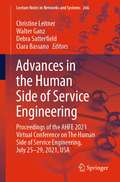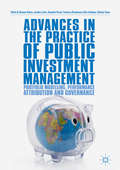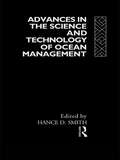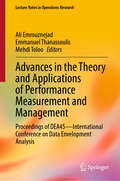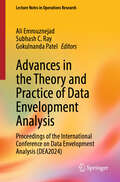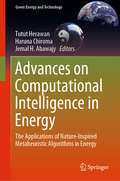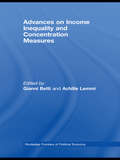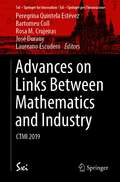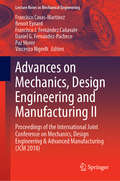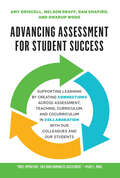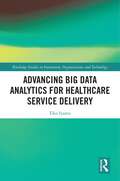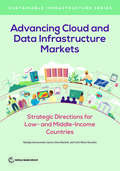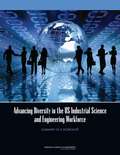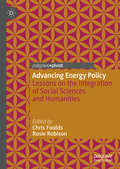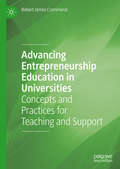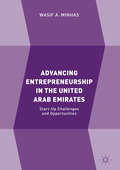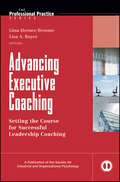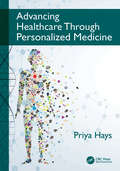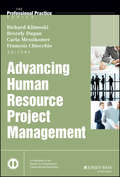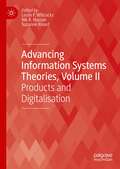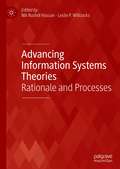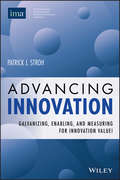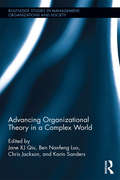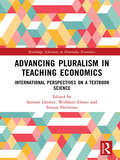- Table View
- List View
Advances in the Human Side of Service Engineering: Proceedings of the AHFE 2021 Virtual Conference on The Human Side of Service Engineering, July 25-29, 2021, USA (Lecture Notes in Networks and Systems #266)
by Walter Ganz Clara Bassano Christine Leitner Debra SatterfieldThis book reports on cutting-edge research and best practices in developing innovative service systems. It covers issues concerning the suitability of a given system for human use, human services, and excellent human experiences. It explores a wide range of ways in which human factors in engineering, ergonomics, human–computer interaction (HCI), cognitive engineering, and many other disciplines can contribute to the design and management of service systems. It considers aspects related to cost effectiveness, ethics, and privacy, among others, and covers applications in many areas, from healthcare to education, transportation, and the economy. Based on the AHFE 2021 Conference on the Human Side of Service Engineering, held virtually on 25–29 July, 2021, from USA, this book provides readers with a comprehensive overview of current research and future challenges in the field of service engineering, together with practical insights into the development of innovative services for various kinds of organizations.
Advances in the Practice of Public Investment Management: Portfolio Modelling, Performance Attribution and Governance
by Narayan Bulusu Joachim Coche Alejandro Reveiz Francisco Rivadeneyra Vahe Sahakyan Ghislain YanouThis book covers the latest advances in the theory and practice of public investment management. It includes the most up-to-date developments in the implementation of public asset management – including multiple contributions on portfolio allocation in varying interest-rate and credit-risk environments. Other highlights include implementation, performance attribution and governance issues surrounding reserves management, portfolio construction techniques appropriate for public investors and an in-depth discussion of the challenges to achieving international diversification.
Advances in the Science and Technology of Ocean Management (Routledge Advances in Maritime Research)
by Hance SmithThis book reviews key developments in the field of marine science and technology. It focuses on three major themes such as the importance of technical developments in ocean management, the application of these developments to specific sea uses ranging from fish farming to the disposal of industrial waste, and the long-term issues that such developments raise.
Advances in the Theory and Applications of Performance Measurement and Management: Proceedings of DEA45—International Conference on Data Envelopment Analysis (Lecture Notes in Operations Research)
by Ali Emrouznejad Emmanuel Thanassoulis Mehdi TolooThis book presents selected proceedings of DEA45: International Conference on Data Envelopment Analysis, which was held September 4-6, 2023, at Surrey Business School, University of Surrey, Guildford, UK. It contains theoretical and empirical papers on Data Envelopment Analysis (DEA) and related fields with a focus on performance measurement and management. It discusses the latest research and developments and their application in various areas such as regulation, agriculture, education, financial and health services. The book is of interest to both researchers and practitioners working on or utilizing the DEA method for examining efficiencies across various organizations.
Advances in the Theory and Practice of Data Envelopment Analysis: Proceedings of the International Conference on Data Envelopment Analysis (DEA2024) (Lecture Notes in Operations Research)
by Ali Emrouznejad Subhash C. Ray Gokulnanda PatelThis book presents selected proceedings from the International Conference on Data Envelopment Analysis (DEA 2024), held from November 18–21, 2024, at the Birla Institute of Management Technology (BIMTECH Noida), Delhi, India. It features theoretical and empirical papers on Data Envelopment Analysis (DEA) and related fields, with a focus on performance measurement and management. The contributions highlight recent research, methodological advancements, and practical applications of DEA in addressing policy and operational issues. This book will be of interest to both researchers and practitioners working with DEA to assess efficiency across diverse organizational contexts
Advances on Computational Intelligence in Energy: The Applications of Nature-Inspired Metaheuristic Algorithms in Energy (Green Energy and Technology)
by Jemal H. Abawajy Tutut Herawan Haruna ChiromaAddressing the applications of computational intelligence algorithms in energy, this book presents a systematic procedure that illustrates the practical steps required for applying bio-inspired, meta-heuristic algorithms in energy, such as the prediction of oil consumption and other energy products. Contributions include research findings, projects, surveying work and industrial experiences that describe significant advances in the applications of computational intelligence algorithms in energy. For easy understanding, the text provides practical simulation results, convergence and learning curves as well as illustrations and tables. Providing a valuable resource for undergraduate and postgraduate students alike, it is also intended for researchers in the fields of computational intelligence and energy.
Advances on Income Inequality and Concentration Measures (Routledge Frontiers Of Political Economy Ser.)
by Gianni Betti Achille LemmiThis impressive collection from some of today‘s leading distributional analysts provides an overview a wide range of economic, statistical and sociological relationships that have been opened up for scientific study by the work of two turn-of-the-20th-century economists: C. Gini and M. O. Lorenz. The authors include such figues as Barry A
Advances on Links Between Mathematics and Industry: CTMI 2019 (SxI - Springer for Innovation / SxI - Springer per l'Innovazione #15)
by Peregrina Quintela Estévez Bartomeu Coll Rosa M. Crujeiras José Durany Laureano EscuderoThis book results from the talks presented at the First Conference on Transfer between Mathematics & Industry (CTMI 2019). Its goal is to promote and disseminate the mathematical tools for Statistics & Big Data, MSO (Modeling, Simulation and Optimization) and their industrial applications. In this volume, the reader will find innovative advances in the automotive, energy, railway, logistics, and materials sectors. In addition, Advances CTMI 2019 promotes the opening of new research lines aiming to provide suitable solutions for the industrial and societal challenges. Fostering effective interaction between Academia and Industry is our main purpose with this book. CTMI conferences are one of the main forums where significant advances in industrial mathematics are presented, bringing together outstanding leaders from business, science and Academia to promote the use of mathematics for an innovative industry.
Advances on Mechanics, Design Engineering and Manufacturing II: Proceedings of the International Joint Conference on Mechanics, Design Engineering & Advanced Manufacturing (JCM 2018) (Lecture Notes in Mechanical Engineering)
by Benoit Eynard Vincenzo Nigrelli Francisco Cavas-Martínez Francisco J. Fernández Cañavate Daniel G. Fernández-Pacheco Paz MorerThis book contains the papers presented at the International Joint Conference on Mechanics, Design Engineering and Advanced Manufacturing (JCM 2018), held on 20-22 June 2018 in Cartagena, Spain. It reports on cutting-edge topics in product design and manufacturing, such as industrial methods for integrated product and process design; innovative design; and computer-aided design. Further topics covered include virtual simulation and reverse engineering; additive manufacturing; product manufacturing; engineering methods in medicine and education; representation techniques; and nautical, aeronautics and aerospace design and modeling. The book is divided into six main sections, reflecting the focus and primary themes of the conference. The contributions presented here will not only provide researchers, engineers and experts in a range of industrial engineering subfields with extensive information to support their daily work; they are also intended to stimulate new research directions, advanced applications of the methods discussed, and future interdisciplinary collaborations.
Advancing Assessment for Student Success: Supporting Learning by Creating Connections Across Assessment, Teaching, Curriculum, and Cocurriculum in Collaboration With Our Colleagues and Our Students
by Dan Shapiro Nelson Graff Amy Driscoll Swarup WoodThis book is about student success and how to support and improve it. It takes as its point of departure that we--as faculty, assessment directors, student affairs professionals, and staff--reflect together in a purposeful and informed way about how our teaching, curricula, the co-curriculum, and assessment work in concert to support and improve student learning and success. It also requires that we do so in collaboration with our colleagues and our students for the rich insights that we gain from them.Conversational in style, this book offers a wide variety of illustrations of how your peers are putting assessment into practice in ways that are meaningful to them and their institutions, and that lead to improved student learning. The authors provide rich guidance for activities ranging from everyday classroom teaching and assessment to using assessment to improve programs and entire institutions.The authors envisage individual faculty at four-year institutions and community colleges as their main audience, whether those faculty are focused on their own classes or support their colleagues through leadership roles in assessment. If you plan to remain focused on your own courses and students, you will find that those sections of this book will help you better understand why and how assessment leaders do what they do, which in turn will make your participation in assessment more engaging and increase your expertise in facilitating student learning. Because the authors also aim to strengthen connections between the curriculum and co-curriculum and include examples of co-curricular assessment, student affairs professionals and staff interested in doing the same will also find ideas in this book relevant to their work.Opening with a chapter on equity in assessment practice, so critical to learning from and benefitting our diverse students, the authors guide you through the development and use of learning outcomes, the design of assignments with attention to clear prompts and rubrics, and the achievement of alignment and coherence in pedagogy, curriculum, and assessment to better support student engagement, achievement and success. The chapter on using student evidence for improvement offers support, resources, and recommendations for doing so, and demonstrates exciting uses of student wisdom.The book concludes by emphasizing the importance of reflection in assessment practices--offering powerful examples and strategies for professional development--and by describing appropriate, creative, and effective approaches for communicating assessment information with attention to purpose and audience.
Advancing Big Data Analytics for Healthcare Service Delivery (Routledge Studies in Innovation, Organizations and Technology)
by Tiko IyamuIn recent years, there has been steady increase in the interest shown in both big data analytics and the use of information technology (IT) solutions to improve healthcare services. Despite the growing interest, there are limited materials, to addressing the needs and challenges posed by the activities and processes including the use of big data. From IT solutions’ perspectives, this book aims to advance the deployment and use of big data analytics to increase patients’ big data usefulness and improve healthcare service delivery. The book provides significant insights and useful guide on how to access and manage big data, in improving healthcare service delivery. The book contributes a fresh perspective, which primarily comes from the complementary use of analytics approach with actor-network theory (ANT), and other techniques, in advancing healthcare service delivery. Accessing and managing healthcare big data have always been a challenging exercise. Due to the sensitivity of the health sector, the focus on patients’ big data is from either technical or social perspective. Thus, the book employs sociotechnical theories, ANT and structuration theory (ST) as lenses to examine and explain the factors that enable and constrain the use of patients’ big data for health services. By doing so, the book brings a different dimension and advance health service delivery. Providing a timely and important contribution to this critical area, this book is a valuable, international resource for academics, postgraduate students and researchers in the areas of IT, big data analytics, data management and health informatics.
Advancing Cloud and Data Infrastructure Markets: Strategic Directions for Low- and Middle-Income Countries (Sustainable Infrastructure)
by Carlo Maria Rossotto Natalija Gelvanovska-Garcia Vaiva MaÄ?iulÄ—The World Development Report 2021: Data for Better Lives underscored today’s unprecedented generation and flow of digital data and noted that much of the value remains untapped. To realize the enormous potential, data need to be supported by technologically advanced infrastructure to capture, analyze, share, and use them efficiently and effectively to benefit economies and societies. Cloud and data infrastructure presents the technological means to enable these processes, but the markets for these services are largely located in high-income countries. Countries with limited access to affordable services will lag in the ability to harness at scale the advanced technologies, such as machine learning and artificial intelligence, and to realize the potential corresponding social and economic gains. Advancing Cloud and Data Infrastructure Markets: Strategic Directions for Low- and Middle- Income Countries is part of a joint World Bank-IFC effort to support countries on their path to developing these markets. This report analyzes the key drivers of cloud and data infrastructure growth in these settings. It examines the business models, policies, and regulatory environment shaping the market trends as data from public and private sectors migrate to the cloud, and it explores the challenges in attracting investments. The report notes that although there is no one-size-fits all solution, essential elements to foster an enabling environment include bold vision and decisive government action to provide the following: 1. Stable business environments; technically skilled workforces; clear and supportive regulatory landscapes; and resilient, reliable, and affordable energy and broadband infrastructure 2. Stimulus for demand by digitalizing public services and migrating them to the cloud, signaling trust and confidence in cloud-enabled services and encouraging domestic businesses to follow suit 3. Streamlined measures to shorten the time from concept to launch of cloud infrastructure 4. Regulations and incentives to reduce the environmental footprint of cloud and data infrastructure, including renewable energy generation and efficient utilization of physical space at the design stage. Public and private stakeholders working together will expedite the ability of all countries and economies to successfully harness the transformative benefits of the cloud to help realize the goal of a world without poverty on a livable planet.
Advancing Diversity in the US Industrial Science and Engineering Workforce: Summary of a Workshop
by Rita S. GuentherThousands of gifted individuals, including women and underrepresented minorities, remain a disproportionally small fraction of those in science, technology, engineering, and math (STEM) careers. Industry, as the largest employer category of those with STEM backgrounds, stands to benefit considerably from greater inclusion of women and underrepresented minorities in the workforce. However, nothing short of a game-changing environment must be created to harness the talent of those not fully represented in the STEM workforce. Advancing Diversity in the US Industrial Science and Engineering Workforce is the summary of a workshop held in May, 2012 by the National Academy of Engineering, focusing on the needs and challenges facing industry in particular, and it is intended to facilitate further discussion and actions to address these complex issues. The workshop provided a forum for leaders from industry, academia, and professional associations to share best practices and innovative approaches to recruiting, retaining, and advancing women and underrepresented minorities in the scientific and engineering workforce throughout the nation's industries.
Advancing Energy Policy: Lessons on the integration of Social Sciences and Humanities
by Chris Foulds Rosie RobisonThis open access book advocates for the Social Sciences and Humanities to be more involved in energy policymaking. It forms part of the European platform for energy-related Social Sciences and Humanities’ activities, and works on the premise that crossing disciplines is essential. All of its contributions are highly interdisciplinary, with each chapter grounded in at least three different Social Sciences and Humanities disciplines. These varying perspectives come together to cover an array of issues relevant to the energy transition, including: energy poverty, justice, political ecology, governance, behaviours, imaginaries, systems approaches, modelling, as well as the particular challenges faced by interdisciplinary work. As a whole, the book presents new ideas for future energy policy, particularly at the European level. It is a valuable resource for energy researchers interested in interdisciplinary and society-relevant perspectives. Those working outside the Social Sciences and Humanities will find this book an accessible way of learning more about how these subjects can constructively contribute to energy policy.
Advancing Entrepreneurship Education in Universities: Concepts and Practices for Teaching and Support
by Robert James CrammondIn the context of the changing nature of universities, this book discusses the progression of enterprise and entrepreneurship education, and conceptualises ‘best practice’ with the aim of enhancing teaching and support for entrepreneurs. Including an overview of entrepreneurship, teaching entrepreneurship, enterprising universities and industrial ecosystems, the author also discusses stakeholder theory and analysis, concluding with a perspective on effective and enterprising learning spaces. An insightful read for researchers, educators and policy-makers, this comprehensive overview provides up-to-date literature and case studies to describe the need for entrepreneurship education, its growth, the influence of key institutional stakeholders, and the future of programme delivery and assessment.
Advancing Entrepreneurship in the United Arab Emirates: Start-up Challenges And Opportunities
by Wasif A. MinhasExplores the role of the entrepreneurs within the economic theory frameworks and types of contribution they make.<P><P> Delves deep into social structures and relationships that heavily influence Emirati behaviour and uncovers how these constructs affect entrepreneurship in the region.<P> Highlights contrasting notions of how entrepreneurship can or should be supported and compares these notions with how entrepreneurship is being supported within the UAE.<P> Discusses the potential and role of accelerators and incubators in advancing entrepreneurship.<P> Reflecting increasing investment in entrepreneurship in the United Arab Emirates (UAE), this new book offers extensive coverage of the factors that enable Emiratis to start and grow a business. Exploring the challenges faced by local start-ups, this book provides insight into the way that entrepreneurship is both perceived and governed in the UAE and how this differs to other countries. The author builds on rich empirical research to propose a model of entrepreneurship which is specific to the UAE, taking into account the role of culture, family and government support. This innovative book underlines the importance of human behaviour in creating successful Emirati start-ups and business opportunities.
Advancing Executive Coaching
by Gina Hernez-Broome Lisa A. BoyceFor anyone who coaches leaders, this book addresses the most critical issues impacting the future of leadership coaching as an organizational development initiative. It is organized around a Leadership Coaching Framework that employs a systems approach to frame the myriad issues. In addition to the introductory chapter that provides an overview of the book, the sixteen contributed chapters are grouped into three sections with the final chapter providing a review of the major themes in the volume with a discussion integrating the global discussions and future directions for leadership coaching.
Advancing Healthcare Through Personalized Medicine
by Priya HaysThis innovative book provides a unique perspective on the biomedical and societal implications of personalized medicine and how it will help mitigate the healthcare crisis and rein in ever-growing expenditure. It introduces the reader to underlying concepts at the heart of personalized medicine - pharmacogenomics, targeted therapies and individualized diagnosis and treatment - and shows how, with the advent of genomic technologies, clinicians will have the capability to predict and diagnose disease more efficiently. Advocating a patient-centred approach at the heart of care, this introduction to personalized medicine, the science behind it, its economic effects, its effects upon patients and its overall implications for society will be invaluable to clinicians, to healthcare providers and to patients.
Advancing Human Resource Project Management
by Richard J. Klimoski Carla Messikomer Francois Chiocchio Beverly DuganGet real-world solutions and evidence-based guidelines for HRproject management challenges Tackling major human resources management projects can bedaunting, but now you can learn from the lessons of HRprofessionals who have encountered roadblocks or challenges insimilar contexts. Advancing Human Resource ProjectManagement is an in-depth, thoughtful resource that highlightsthe knowledge and experience of those who have undertaken large HRprojects. This guide illustrates what worked and what didn't, witha focus on evidence and real-world cases to illuminate effectivestrategies and solutions. Each chapter presents empirical findingscomplemented by professional judgment and wisdom from humanresource management professionals well-versed in global businessenvironments.Advancing Human Resource Project Management recognizesthe importance of context, addresses the practical and professionalimplications of managing HR management projects in differentindustry sectors, and provides comprehensive coverage onimplementing global development programs and project initiation andplanning. Ideal for global Industrial and Organizational Psychologyfaculty and practitioners, graduate students, and, especially, HRprofessionals, this resource uncovers the best evidence-basedpractices available today for effective HR project managementstrategies. The book includes:An emphasis on the implications and challenges of providingsolutions for HR business problems on a global scaleReal-world cases and firsthand professional experiences withsummaries of knowledge gained from research and practiceAdvice on tackling challenges inherent in various stages of aprojectExpertise and counsel from HR professionals familiar with largeprojects and from those who study and work in the field of projectmanagementLet this comprehensive resource guide your approach toinitiating and managing large HR projects. With solid, empiricalevidence and relatable case studies, Advancing Human ResourceProject Management is the ideal professional companion forthose looking to strengthen their project techniques, projectleadership, and management skills.
Advancing Information Systems Theories, Volume II: Products and Digitalisation (Technology, Work and Globalization)
by Leslie P. Willcocks Suzanne Rivard Nik R. HassanInformation systems research (IS) is an exciting multidisciplinary area that links the rapidly changing technology of information (or communications and information technology, ICT) to the business and social environment. Lately, the discourse surrounding information and systems has leaped into the consciousness of the public in unprecedented ways through the rise of social media, the Internet of Things (IoT), 'fake news' and the weaponization of information, to name a few. Unfortunately, it has been felt that these developments are overtaking the ability of the IS field to address them, in part, because the field itself lacks its own native theories. It is well known that the IS field undertakes its research using theories from its 'reference disciplines' such as management, social psychology, economics, communication and computer science, but what this book offers is a clarification and implementation of the discipline's own foundational theory. This book is the companion volume to Advancing Information Systems Theories: Volume I, and part of a three part series that aims to advance IS research. This volume addresses the products of information systems theories, examining design principles, information, practice principles for robotics, and other concepts integral to developing theory. The book will be of interest to academics studying information systems, Big Data, digital business, information technology, innovation management, and digital management.
Advancing Information Systems Theories: Rationale and Processes (Technology, Work and Globalization)
by Leslie P. Willcocks Nik Rushdi HassanThe information systems (IS) field represents a multidisciplinary area that links the rapidly changing technology of information (or communications and information technology, ICT) to the business and social environment. Despite the potential that the IS field has to develop its own native theories to address current issues involving ICT it has consistently borrowed theories from its “reference disciplines,” often uncritically, to legitimize its research. This volume is the first of a series intended to advance IS research beyond this form of borrowed legitimization and derivative research towards fresh and original research that naturally comes from its own theories. It is inconceivable for a field so relevant to the era of the hyper-connected society, disruptive technologies, big data, social media, "fake news" and the weaponization of information to not be brimming with its own theories. The first step in reaching the goal of developing native IS theories is to reach an agreement on the need for theory (its rationale) and its role as the most distinctive product of human intellectual activity. This volume addresses what theories are, why bother with theories and the process of theorizing itself because the process of developing theories cannot be divorced from the product of that process. It will lay out a research agenda for decades to come and will be invaluable reading for any academic in the IS field and related disciplines concerned with information, systems, technology and their management.
Advancing Innovation: Galvanizing, Enabling, and Measuring for Innovation Value!
by Patrick J. StrohMaster the standards and interpretations that govern preparation, compilation, and review engagements with this authoritative resource Advancing Innovation: Galvanizing, Enabling, and Measuring for Innovation Value! provides readers with a comprehensive treatment of how to perform engagements while complying with the Statements on Standards for Accounting and Review Services (SSARS). Newly updated, Advancing Innovation delivers practical guidance for the application of the standards to readers’ specific circumstances. Written by two celebrated accountants and businesspeople, Robert S. Kaplan and Patrick Stroh, Advancing Innovation includes: Fully indexed topics arranged by subject Clarified standards that provide a framework for planning and performing an engagement that meets client needs Explanations of amendments, deleted or superseded content, and conforming changes due to the issuance of other authoritative guidance Perfect for any accountant expected to perform preparation, compilation, or review engagements, Advancing Innovation covers all SSARSs, including SSARS No. 21 through 25, the last of which further converges AR-C section 90 with ISRE 2400 (Revised).
Advancing Leadership Theory and Practice
by Nitin Nohria Rakesh KhuranaMore than a means of getting ahead and gaining power, leadership must be understood as a serious professional and personal responsibility. In this introductory chapter, editors Nitin Nohria, the dean of Harvard Business School, and Rakesh Khurana, a professor of leadership development at HBS, point out that while many university graduate programs in business, law, education, and public policy claim that their mission is to educate leaders who will advance the well-being of society, the reality is that scholarly research on leadership is, at best, at the periphery of these same universities. In fact, the increasing demand for insights about leadership has largely been met by popular writers-consultants, journalists, or "iconic" business leaders. The papers that comprise this book-originally presented at the Harvard Business School Centennial Colloquium, "Leadership: Advancing an Intellectual Discipline"-are a starting point. Nohria and Khurana define five dualities that they believe are at the heart of research on leadership-for example, the duality between the leader's role in producing superior results and the leader's role in creating meaning. The chapter concludes with a brief summary of each of the book's 25 subsequent chapters. This chapter was originally published as Chapter 1 of "Handbook of Leadership Theory and Practice: A Harvard Business School Centennial Colloquium."
Advancing Organizational Theory in a Complex World: Advancing Research in a Complex World (Routledge Studies in Management, Organizations and Society)
by Chris Jackson Jane Qiu Ben Nanfeng Luo Karin SandersWhile research in organisational studies has become increasingly rich and complex, organisation researchers are constantly challenged by the growing quest for theoretical advancement and innovation. To conduct theoretically rigorous and innovative research, contemporary researchers and students must develop in-depth understanding of the theoretical traditions and future prospects of their discipline. This book provides a collection of cutting-edge research topics in the field of organisation and management and offers advanced research findings that explore the frontiers of the field. Advancing Organisational Theory in a Complex World aims to provide deep insights into many influential organisational theories, including, contingency theory, institutional theory, stewardship theory, population ecology theory, ambidexterity, and complexity theory. All these theories have been developed to explain the external and internal factors that influence organisational survival and evolvement. We focus on these theories because they represent some of the most important ways into the modern literature, counter-points to the modern literature, and a breath of fresh air to some theories which should be better known. This book shows the fruitfulness and the continuous vitality of the theoretical field of organisational studies in a critical and innovative way. Finally, this book is dedicated to Professor Lex Donaldson who is a thought leader in the field. The field owed this to Lex, for his lifelong dedication to organisational studies and for his creation and advancement of theories that have inspired several generations of researchers.
Advancing Pluralism in Teaching Economics: International Perspectives on a Textbook Science (Routledge Advances in Heterodox Economics)
by Wolfram Elsner Samuel Decker Svenja FlechtnerThe complex economic problems of the 21st century require a pluralist, real-world oriented and innovative discipline of economics that is capable of addressing and teaching these issues to students. This volume is a state-of-the-art compilation of diverse, innovative and international perspectives on the rationales for and pathways towards pluralist economics teaching. It fosters constructive controversy aiming to incite authors and commentators to engage in fruitful debates. This volume addresses a number of key questions: Why is it important for a social science to engage in pluralistic teaching? What issues does pluralist teaching face in different national contexts? Which traditions and practices in economic teaching make pluralist teaching difficult? What makes economics as a canonical textbook science particular and how could the rigid textbook system be innovated in a meaningful way? What can we learn from school education and other social science disciplines? Through examining these issues the editors have created a pluralist but cohesive book on teaching economics in the contemporary classroom drawing from ideas and examples from around the world. Advancing Pluralism in Teaching Economics offers a valuable insight into the methodology and application of pluralist economics teaching. It will be a great resource for those teaching economics at various levels, as well as researchers.
